A bronze compartmented stamp seal pendant in the form of a horned quadruped, with suspension loop to reverse; accompanied by a typed and signed scholarly note by W.G. Lambert, the late Professor of Assyriology at the University of Birmingham, 1970-1993, which states: '...This has the shape of what is depicted: a standing horned quadruped looking upwards. The face is flat and compartmented. The back is also flat and has a loop handle with two grooves over it. This comes from west central Asia and dates to c.2300-2000 B.C. It is in very good condition and the metal has been conserved.' 11 grams, 38 mm
1980s-early 1990s collection, UK.
Accompanied by an original typed and signed scholarly note issued by the late Professor W.G. Lambert.
A Ghaznavid style squat bowl with convex wall and rounded base, worn remains of punched ring-and-dot decoration to the exterior. 741 grams, 25 cm wideFine condition.
English collection formed in the 1990s.
UK art market.
Property of an Essex gentleman.
A pair of heavy copper-alloy pendants formed as large pyramid clusters with protrusions to the bulbs, bulbous suspension loop above. 180 grams total, 49-53 mm
Early 1990s London collection.
Acquired on the UK art market.
From a private collection, Lancashire, UK.
A drum-shaped stone cylinder seal with figural frieze; accompanied by an old scholarly note, typed and signed by W.G. Lambert, late Professor of Assyriology, University of Birmingham, 1970-1993, which states: 'Cylinder seal of red stone, 18 x 20 mm. Frieze of four walking women holding standards. Mesopotamia, c.3000 B.C. Condition fine.' 13.7 grams, 18 mm
From an important family collection.
Examined by Professor Wilfrid George Lambert FBA (1926-2011), historian, archaeologist, and specialist in Assyriology and Near Eastern archaeology, in the late 1980s and early 1990s.
Accompanied by an old scholarly note, typed and signed by W.G. Lambert, late Professor of Assyriology, University of Birmingham, 1970-1993.
Cf. The Metropolitan Museum, New York, accession number 62.70.74, for similar.
The majority of a pillow-shaped clay tablet, bearing cuneiform text to the upper part of one face and top edge, together with rulings(?) for additional text, a summary table relating to a distribution of consumables; Kingdom of Larsa, a note indicates in which unit of measurement the quantity of beer was estimated. 100 grams, 68 mm
Specialised collection of cuneiform texts, the property of a London gentleman and housed in London before 1992.
Thence by descent to family members.
Examined by Professor Wilfrid George Lambert FBA (1926-2011), historian, archaeologist, and specialist in Assyriology and Near Eastern archaeology, in the late 1980s and early 1990s.
This small collection is exceptional for the variety of types, including some very rare and well preserved examples.
Sold for (Inc. bp): £1,080
A copper-alloy vessel with tapering walls and everted rim, two raised circumferential ribs framing a frieze of engraved stylised birds standing right beneath arcades. 334 grams, 15 cm wideFine condition.
Acquired before 1983.
Ex London gallery, 1990s.
See Moorey, P.R.S. et al., Ancient Bronzes, Ceramics and Seals, Los Angeles, 1981, for discussion and for broadly comparable vessels.
A piriform ceramic vessel with short neck and inverted rim, painted with hatched triangles over a frieze of processing zebu bulls with solid circles in the field. 380 grams, 20 cm high
Acquired 1980-2015.
Ex Abelita family collection.
A bronze attachment with a curved, round-section body, an incomplete hoop to one arm and a lion-head terminal to the other, with a collar and stylised detailing to mane and face. 32.7 grams, 49 mm wideFine condition.
Ex private family collection formed in London, mid 1980s to early 1990s.
A bronze compartmented stamp seal in the form of a stylised bovine, suspension loop to reverse; accompanied by a typed and signed scholarly note by W.G. Lambert, the late Professor of Assyriology at the University of Birmingham, 1970-1993, which states: '...This is a compartmented seal, not openwork, with a stout suspension loop on the back. The shape is that of a bovine with short curly tail, heavy body, thick neck and only a very slight hump. For practical reasons there are only the shortest of horns, where, as with the feet, the ridge around the edges of the seal is not continued. This comes from west central Asia, and dates to c.2300-2000 B.C. It is a very rare piece of great merit.' 22 grams, 52 mm
1980s-early 1990s collection, UK.
Accompanied by an original typed and signed scholarly note issued by the late Professor W.G. Lambert.
A domed silver mount displaying a repoussé scene composed of a lion and antelope in combat. 6.13 grams, 42 mm
Essex gallery, early 2000s.
A bulbous ceramic vessel painted with a frieze of 'eye' motifs between parallel bands. 242 grams, 10 cm wide
Acquired 1990s.
English private collection.
Property of an Essex gentleman.
A terracotta vase with bulbous body, small disc base, trumpet-shaped mouth; bands of painted rings to the neck, frieze of birds and leaves to the shoulder, rim chipped. 285 grams, 13.5 cm highFine condition.
Acquired 1980-2015.
Ex Abelita family collection.
Cf. Satyawadi, S., Proto-Historic Pottery of Indus Valley Civilisation: Study of Painted Motifs, Perspectives in Indian Art and Archaeology vol.2, New Delhi, 1994, chart 8.


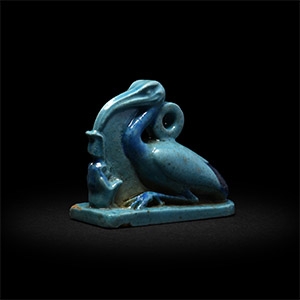



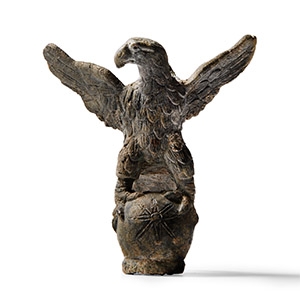
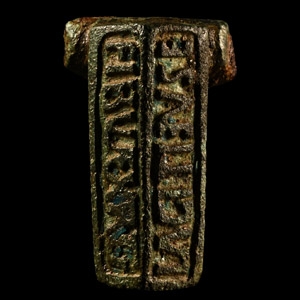

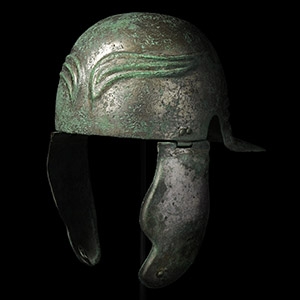
.jpg)
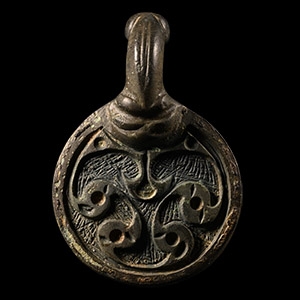
.jpg)
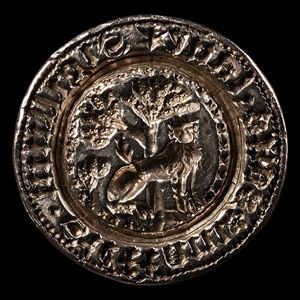
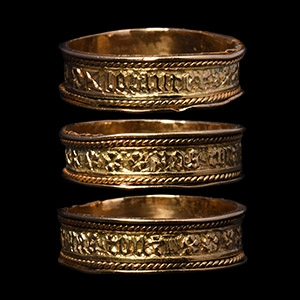


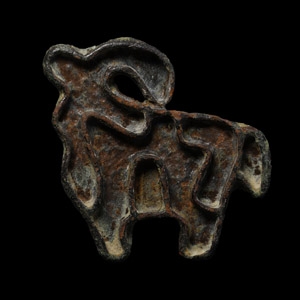

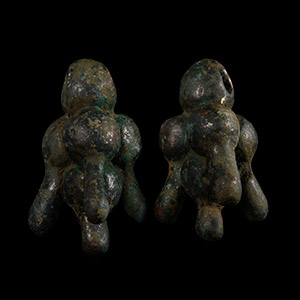
.jpg)
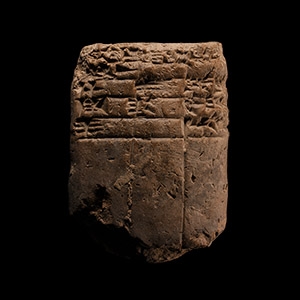
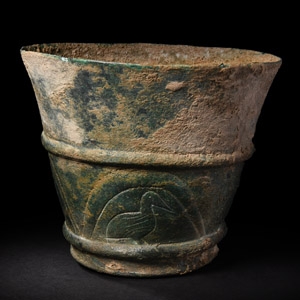

.jpg)


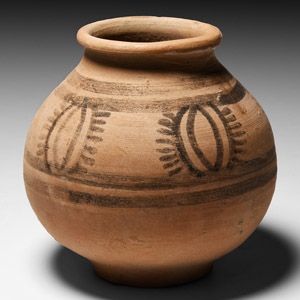
.jpg)



